Udon
Udon (うどん, also 饂飩) is a thick noodle made from wheat flour, used in Japanese cuisine. Its simplest form is in a hot soup as kake udon with a mild broth called kakejiru made from dashi, soy sauce, and mirin. It is usually topped with thinly chopped scallions. Other common toppings include prawn tempura, kakiage (mixed tempura fritter), abura-age (sweet, deep-fried tofu pouches), kamaboko (sliced fish cake), and shichimi spice added to taste.
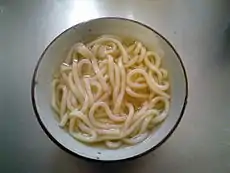 Kake udon, udon noodles in hot broth | |
| Type | Noodles |
|---|---|
| Place of origin | Japan |
| Serving temperature | Hot or cold |
| Main ingredients | Wheat flour |
Standard broth differs by region. Dark (koikuchi) soy sauce is added in eastern Japan, while light (usukuchi) soy sauce is added in the west. Notably, instant noodles are often sold in two versions accordingly.
More unusual variants include stir-fried yaki udon and curry udon made with Japanese curry.
Origin

There are many stories explaining the origin of udon.
One story says that in AD 1241, Enni, a Rinzai monk, introduced flour milling technology from Song China to Japan. Floured crops were then made into noodles such as udon, soba, and pancakes in Japan which were eaten by locals. Milling techniques were spread around the country.
Another story states that during the Nara period, a Japanese envoy was introduced to 14 kinds of confection while being in China during the Tang Dynasty. One of them was called sakubei (索餅), which was listed as muginawa (牟義縄) in Shinsen Jikyō (新撰字鏡), a dictionary which was published in the Heian Era. The muginawa is believed to be an origin for many kinds of Japanese noodles. However, the muginawa in Shinsen Jikyō was made with wheat and rice flour.
Another story for udon claims that the original name of the noodle was konton, which was made with wheat flour and sweet fillings.
Yet another story says that a Buddhist priest called Kukai introduced udon noodles to Shikoku during the Heian Era. Kūkai, the Buddhist priest, traveled to Tang China around the beginning of the 9th century to study. Sanuki Province claimed to have been the first to adopt udon noodles from Kūkai. Hakata claimed to have produced udon noodles based on Enni's recipe.
Dishes
Udon noodles are boiled in a pot of hot water. Depending on the type of udon, the way it is served is different as well. Udon noodles are usually served chilled in the summer and hot in the winter. In the Edo period, the thicker wheat noodle was generally called udon, and served with a hot broth called nurumugi (温麦). The chilled variety was called hiyamugi (冷麦).
Cold udon, or udon salad, is usually mixed with egg omelette slices, shredded chicken and fresh vegetables, such as cucumber and radish. Toppings of Udon soup are chosen to reflect the seasons. Most toppings are added without much cooking, although there are also deep-fried tempura. Many of these dishes may also be prepared with soba.
Hot
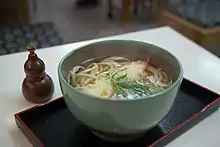
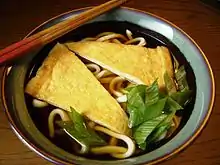
- Chikara udon ("power udon"): topped with toasted mochi rice cakes.
- Haikara udon ("modern udon"): see tanuki udon. from wiktionary:ハイカラ
- Kake udon (in Kantō) or su udon (in Kansai): hot udon in broth topped with thinly sliced green onions, and perhaps a slice of kamaboko.
- Kamaage udon: served in a communal hot-pot with hot water, and accompanied by a hot dipping sauce of dashi sukiyaki.
- Karē nanban or karē udon ("curry udon"): modern udon served in a spicy curry-flavoured broth, which may also include meat or vegetables. The term nanban is a reference to the Nanban trade which had influenced Japanese culture for a century before being banned in 1639 by the Edo Shogunate.[1] Biei, Hokkaido is famous for a unique curry udon..
- Kitsune udon ("fox udon"): topped with aburaage (sweet, deep-fried tofu pouches). The dish is called "fox" because of its association with aburaage.[2] Originated in Osaka. Kitsune udon is often mistaken for Tanuki udon.
- Nabeyaki udon: a sort of udon hot-pot, with seafood and vegetables cooked in a nabe, or metal pot. The most common ingredients are tempura shrimp with mushrooms and an egg cracked on top.
- Oyako udon: chicken and egg, with sliced onion in a sweetened dashi soup over udon. It has a sweet savory flavor.
- Su udon: see kake udon
- Sutamina udon ("stamina udon"): udon with various hearty ingredients, usually including meat, a raw egg, and vegetables.
- Tanuki udon (in Kantō)[2] or Haikara udon (in Kansai):[2] topped with tempura batter pieces. Tanuki udon is often mistaken for kitsune udon.
- Tempura udon: topped with tempura, especially prawn, or kakiage, a type of mixed tempura fritter.
- Tsukimi udon ("moon-viewing udon"): topped with raw egg, which poaches in the hot soup.
- Wakame udon: topped with wakame, a dark green seaweed.
- Yaki udon: stir-fried udon in soy-based sauce, prepared in a similar manner to yakisoba. Originated in Kitakyushu, Fukuoka Prefecture. Note that while yaki udon is made with udon, yakisoba is made with steamed Chinese-style ramen, not buckwheat soba.
Cold
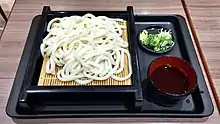
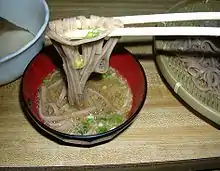
- Bukkake udon: cold udon served with thick dashi broth.[3]
- Hadaka udon (裸うどん, "naked udon"): cold udon served on its own.
- Kijōyu udon: served in a cold soup of raw (unpasteurized) soy sauce and sudachi (a type of citrus) juice, sometimes with a bit of grated daikon.
- Zaru udon: chilled udon noodles topped with shredded nori and served on a zaru (笊 or ざる), a sieve-like bamboo tray. Accompanied by a chilled dipping sauce, usually a strong mixture of dashi, mirin, and shoyu. Eaten with wasabi or grated ginger.
Regional varieties
Japan
There are wide variations in both thickness and shape for udon noodles.
- Dango-jiru (団子汁): similar to the Hohtoh, from Ōita Prefecture. Nominally a "dumpling soup", it resembles very thick, flat udon.
- Gōsetsu udon (豪雪うどん): a slightly translucent, chewy type from Kutchan, Hokkaido. Literally "heavy snow udon", made from the starch of potatoes. The texture is different from normal udon which is made from flour. At the foot of Mount Yōtei, Hokkaido, the biggest producing area of potatoes, "potato starch udon" was eaten as a home food for farmers from long ago. The ratio of potato starch and wheat flour was improved to make it delicious even after a long time. The origin of the name "heavy snow udon" is the foot of Mount Yōtei, a heavy snowfall area, and the appearance of the noodles which is slightly translucent like snow.[4]
- Hakata udon (博多うどん): a thick and soft type from the Fukuoka.
- Himokawa (ひもかわ): an extreme flat and wide type from Kiryū, Gunma.
- Hōtō (rarely 餺飥, commonly ほうとう): a type of miso soup with a flat and wide type udon and vegetables, particularly kabocha. One of the significant differences between usual udon and Hōtō udon is salt. When Hōtō udon is made, salt is not added to the noodle dough. from Yamanashi Prefecture.
- Inaniwa udon (稲庭うどん): a thin type from Akita Prefecture.
- Ise udon (伊勢うどん): a soft type, usually eaten with sweet soy sauce, from Ise, Mie.
- In Kansai region, a soft and medium thickness type is popular.

- Kishimen (棊子麺, or more commonly きし麺): a flat type from Nagoya.
- Mimi udon (耳うどん, literally "ear udon"): a lucky preserved food in Kuzu, Tochigi. It looks similar to ears.
- Miso-nikomi udon: a local dish of Nagoya, a hard udon simmered in red miso soup. The soup generally contains chicken, a floating cracked raw egg that is stirred in by the eater, kamaboko, vegetables and tubers. The noodles are extremely firm in order to stand up to the prolonged simmering in the soup; additionally, the noodles do not contain salt, so as to avoid over-salting from the salt in the miso.
- Saitama Prefecture has several varieties of udon.
- Kazo udon (加須うどん): produced in Kazo, Saitama, a place of active wheat production. Its very orthodox hand-kneading process characterizes Kazo udon noodles.
- Fukaya Nibōtō (深谷煮ぼうとう): a type of hotoh from Fukaya, Saitama. Boiled noodles using plenty of Fukaya green onions characterize Fuyaya Niboto udon.
- Konosu kawahaba udon (こうのす川幅うどん): originated of Kōnosu, Saitama in 2009. it is characterized by its width that is as wide as eight centimeters.
- Niiza ninjin udon (新座にんじんうどん): originated of Niiza, Saitama in 2002. The noodles are kneaded with carrot and are characterized by their vivid orange color.
- Sanuki udon (讃岐うどん): a thick and rather stiff type from Kagawa Prefecture.
- Sara udon (皿うどん): a specialty of Nagasaki Prefecture. Literally "plate udon," consisting of thinner udon that are deep fried and served with any of a number of toppings.
Korea

In Korea, authentic Japanese udon dishes are served in numerous Japanese restaurants, while the Korean-style udon noodle soups are served in bunsikjip (snack bars) and pojangmacha (street stalls). Both types are called udong (우동), which is the transliteration of the Japanese word udon (うどん).[5] In Korea, the word udong refers to noodle dishes (typically noodle soup), while the noodles themselves are called udong-myeon (우동면; "udong noodles") and considered a type of garak-guksu (가락국수; "thick noodles").[5] Common ingredients for udong noodle soup include crowndaisy greens and eomuk (fish cakes), neither of which are very common in Japanese udon dishes.
Palau
There is also a dish called udon in Palau, because of the former Japanese administration. The broth is soy sauce–based like Japanese udon. However, as there were many immigrants from Okinawa, it uses less broth like Okinawa soba. Most notably, the noodle is that of spaghetti, as it is easier to acquire there.
Tourism and udon

Kagawa prefecture is well-known throughout Japan for its Sanuki udon (讃岐うどん). It is promoted to other regions of Japan through means such as mascots, udon-related souvenirs, as well as movies featuring udon as the main theme.[6]
Gallery
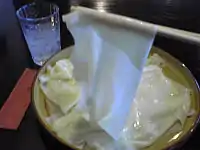 Himokawa
Himokawa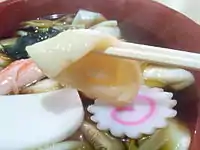 Mimi-udon
Mimi-udon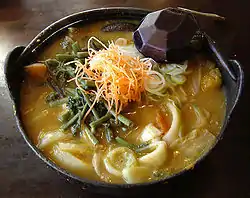 Hōtō
Hōtō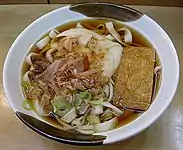 Kishimen
Kishimen Ise-udon
Ise-udon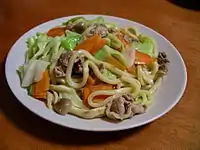 Yaki-udon
Yaki-udon
See also
References
- Itoh, Makiko (2015-05-15). "Nanban dishes are fit for a barbarian". The Japan Times. Retrieved 2019-01-16.
- Itoh, Makiko (2018-11-17). "A comforting udon noodle recipe for the winter season". The Japan Times. Retrieved 2021-01-27.
- Gritzer, Daniel. "Make a splash with bukkake udon (Japanese cold noodles with broth)". Serious Eats. Retrieved 2017-01-27.
- "豪雪うどん | うどん ミュージアム 【うどん 博物館】". Udon Museum (in Japanese). Retrieved 25 April 2018.
- "udong" 우동. Standard Korean Language Dictionary. National Institute of Korean Language. Retrieved 15 March 2017.
- "UDON - 作品 - Yahoo!映画". yahoo.co.jp.
- Tsuji, Shizuo. (1980). Japanese cooking: A simple Art. Kodansha International/USA, New York. ISBN 1568363885
| Wikimedia Commons has media related to Udon. |
| Wikibooks Cookbook has a recipe/module on |